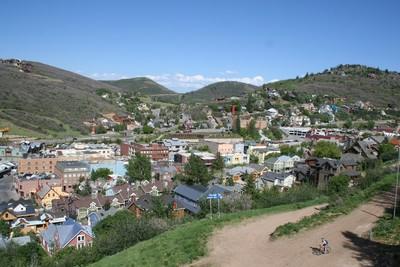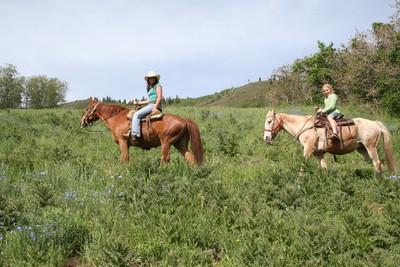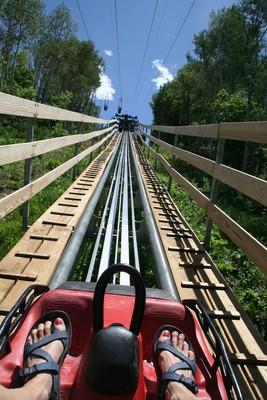CERCA: A Break from the Heat
The ski town of Park City, Utah, gained worldwide attention when it was featured as the site for many alpine and Nordic events during the 2002 Winter Olympics. What is usually not mentioned is that it is also a world-class resort in the summer. Located in the Wasatch Mountain range of the Rocky Mountains, the town sits at an elevation of about 6,900 feet and the neighborhood only goes higher from there. This time of year, you can expect cool, clear days with daytime temperatures averaging in the high 70s.
Although thousands flock here to just be part of the hip and trendy scene, my daughters and I were visiting to take part in some outdoor adventure. Just two weeks ago, Olivia, 20, Charlotte, 10, and I spent several action-packed days in and around the city. By the end of our trip, we had slid down mountainsides at great rates of speed along alpine slides, zip lines, a coaster and even -- an added treat for me -- a bobsled. We also had calmer times on a couple of leisurely hikes, seeing the mountainside by horseback and dining at some of Utah's finest restaurants.
On our first morning, we met up with Carol Potter, executive director of the Mountain Trails Foundation. The foundation oversees about 360 miles of trails in the area, mostly on private land, including those located on the town's three world-class ski resorts. As we walked along the McCleod Creek Trail we were passed by fellow hikers, mountain bikers and joggers.
"You can see what an active, vibrant community we have," Potter said after a handful of athletic friends stopped and chatted with her. She added, "You can't stay inside, it's just too nice here in summer. The climate is perfect."
Park City is not a new destination for me. In fact, I used to live there, taught my two older kids to ski on these mountains and even skied my last race down a Park City trail. While living there, we learned that summers were an added bonus. Back in the old days, we were limited to a few quality biking and hiking trails; now there are hundreds of miles over a variety of terrain for any age and skill level. One, the Mid Mountain Trail, a favorite for two wheels or two feet, runs more than 20 miles at high elevations near the peaks of the area's three ski resorts. It was designated an Epic Ride by the International Mountain Biking Association, the only trail in Utah awarded that prestigious title.
Park City got its start in 1868 when silver was discovered. The mines were most productive from the 1880s to the 1920s, producing not only silver but lead, zinc, copper and some gold. Population around the turn of the century reached 10,000 people. Overall, the mines yielded $400 million and created 23 millionaires in times when there weren't many.
When prices fell in the 1930s, mining slowed down. By the 1950s, although more than 1,000 people still resided here, it was considered by many a ghost town. But unlike other mining towns that turned to dust, Park City reinvented itself, taking advantage of something it had in plenty: winter snow.
Today, the area boasts three world-class ski resorts: Park City Mountain Resort, Deer Valley Resort and The Canyons Resort, each well worth a visit because each offers a different ambience. All of them have lift-served scenic rides that also access the high elevation mountain biking and hiking trails. One of the best scenic rides is the Flight of the Canyons gondola at The Canyons Resort. Here, you can take the ride up to 8,000 feet to mid-mountain and start your hike or mountain bike ride or just go to enjoy the scenery, relax and have lunch at the Red Pine Café.
One of my favorite views in the whole region is from the Deer Valley Resort. Even if you aren't taking advantage of the multitude of trails, it's worth taking the Sterling chair lift up to the summit, where your eyes will feast on far reaching views of the Jordanelle Reservoir to the east and Heber Valley and Mount Timpanogos to the south.
After our McCleod Creek Trail hike, we headed to the Park City Mountain Resort for an afternoon of speed. Like many visitors, we started by taking the Pay Day chair lift up the mountain. Using the lift merely as a scenic ride, taking it up and down without disembarking, is well worth doing. But my adventurous children and I exercised other options. We first took a run down the alpine slide, on tiny wheeled sleds resembling the skeletons seen in the Winter Olympics. Banked turns and fast straight-aways brought us down about 3,000 feet in minutes. Next it was off to the Alpine Coaster, a unique experience. You start this ride at the bottom of the mountain. After being belted tightly into your own personal coaster you take relaxing ride uphill on an elevated track. Once you reach the top of the track you are off. On both Alpine Slide and Alpine Coaster, you can regulate your own speed. On both of these rides, the daring should dawdle long enough that riders in front of them have time to get down, so the speed-addicted can then go as fast as their nerves permit.
On our second morning, we headed back over to Park City Mountain Resort for a scheduled horseback ride that would take us up the mountain about five miles and a couple of thousand feet in elevation. This would take us over wide ski runs covered with wildflowers, and narrow paths through thick stands of aspen and pines.
Emily Johnson from Park City Stables was our wrangler. Although she is a skier, she prefers summers and a horse as her transportation.
"I meet people from around the world at this job," she said.
She has also met some local moose, and pointed out a spot where she had seen one just a few days before. "He was only about 20 yards away, and as our group rode up he just got up slowly and moseyed away."
It's also common to see deer and elk, which we did, and if you keep your eyes and ears open you will find a variety of birds. There are more than 100 species in the area including finches, woodpeckers, hummingbirds, bluebirds, robins, hawks and eagles.
Later we met some friends for lunch at Café Terigo, a local Main Street favorite, and then headed to the Park City Museum. The building, one of the oldest in Park City, once served as city hall and the jail. The museum features interesting displays of the town's pioneer days in both silver-mining and skiing.
A unique display is the cart in which riders sat and made their way up to the slopes, on the world's first underground ski lift. It operated in the 1960s at what is now Park City Mountain Resort. The lift wasn't for anyone who suffered from claustrophobia or time constraints. It took you underground for three miles along an old mine tunnel and then up a mine elevator 1,800 feet to the ski run. It was very slow and I would imagine too frightening for most, and closed down in 1969.
The museum is also home to the old territorial jail. We descended steep steps to the dark and damp basement where we found several old cells, complete with bars, the old metal bed frames, original ankle shackles and the old community toilet, a scare in itself.
I had arranged through the museum to take a one-hour guided walking tour of historic Main Street. This plan was good for everyone. I could immerse myself in the history of Park City while the girls could check out the upscale shops and galleries without me tagging along, an unenthusiastic shopper.
I set off with three other visiting history buffs and our guide, Johanna Fassbender, curator of education for the museum.
As we strolled down Main Street, Fassbender gave us a brief history on the most interesting buildings, as well as showing us mounted 8-by-10-inch photos of them from days of old.
"The history here is tangible," she said, "so many of the old buildings are still intact."
Highlights along the way were a house on the top of Main Street that is said to be haunted. Apparently, a miner came home unexpectedly and found his wife in a compromising position with a fellow from a nearby saloon. Inhospitably, the miner shot him dead.
The most popular stop for our group was the Mary G. Steiner Egyption Theater. Opened in 1926 to replace the old Dewey Theatre, which collapsed in 1916 under heavy snow, it is a replica of Warner's Egyptian theater in Pasadena, Calif. It has been renovated and is used as one of the venues during the popular Sundance Film Festival and the rest of the year used as an off-Broadway-style live theater. Little Shop of Horrors will be shown July 6 through Aug. 18.
Meeting back up with the girls, we all headed by car a few miles away to the Utah Olympic Park. This is a familiar site to anyone who watched the 2002 Winter Olympics, as it was used for their Nordic ski-jumping events, and the sliding sports such as the bobsled, skeleton and luge.
Olivia and Charlotte first headed to the Quicksilver, a stainless steel alpine slide. They both enjoyed it, except Charlotte's braces became embedded with a fly that had flown into her mouth. Once off the ride a few swishes of water detached most of the bug. Next they traveled up the chair lift to the top of the ziplines. There are two for different-sized people, so Charlotte headed to the Ultra Zip and Olivia to the Xtreme Zip. Both were strapped into harness seats that kept them securely vertical as gravity sped them downhill. Olivia hit 50 mph while experiencing a 435-foot vertical drop; it's said to be the world's steepest zipline. Charlotte had a ride somewhat tamer. Meanwhile, I was getting ready to get my thrills by running the entire length of the Olympic bobsled track.
Helmet on tight, I crawled into the second seat of the four-person bobsled and as instructed, made my way up and very close to my driver, Johnny White. White is a 2010 Olympic hopeful who would hopefully bring me down to the bottom in one piece. The last thing I asked him before take-off was if he ever flipped a bobsled. The answer was yes. Not comforting, but he assured me he would not try to break speed records with me aboard, and that he has never flipped with a passenger from the general public.
Three strong young men grabbed the back of the bobsled, pushed it down the track for about 20 yards and then we were off on our own. At first it was thrilling but after reaching full speed, it felt like being aboard an errant rocket ship. Just as I would surrender myself to the force of being practically horizontal on one bank turn, the sled would instantly veer off in another direction. There were so many turns and steep banks I lost count, but after the equivalent of a 12-story-drop, over one minute and five seconds, it was over. The run was timed and we reached speeds of more than 63 miles per hour with four to five Gs of centrifugal force.
Even without snow, winter athletes are still hard at work training for future competitions. After our hair-raising trips down the mountain, we spent a few minutes watching aerial skiers practice their flips and turns into a 750,000-gallon splash pool. Olympic athletes and national team athletes train here on a watered-down surface that closely imitates a snow-covered jump.
One of the best benefits of summer is the accommodations. Although you can find excellent hotels in the area, I would strongly recommend staying in a condo. It's easy to find one that's ideal for your group and budget in any area of town that you want to be in.
We stayed in a two-bedroom, complete with pool and fireplace with views of Park City Resort and overlooking a golf course, all available at a fraction of the winter rates.
GETTING THERE Location: Park City, in northern Utah, about 421 miles from Las Vegas. Directions by car: From Las Vegas take I-15 north about 375 miles to Provo, Utah. Exit to University Ave./U.S. 189 and follow north for about 30 miles to Heber City. Go left on U.S. 40 for about 13 miles to the Park City/Kamas exit. Go left onto Utah 248 about three miles to Park City. Southwest Airlines: At least seven daily nonstop flights from Las Vegas to Salt Lake City, starting at $156 round trip. It is about 35 miles to Park City from Salt Lake City International Airport. All major rental car companies can be found at the airport and shuttle service is available to Park City. www.parkcityinfo.com.



















